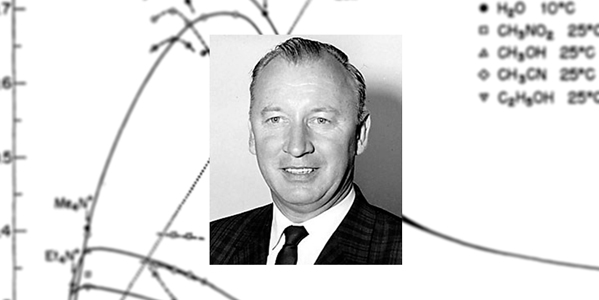
In Memoriam

Aksel Bothner-By
Emeritus Professor of Chemistry Aksel Bothner-By passed away in February 2017 at age 96.
Aksel Bothner-By first arrived at the Mellon Institute for Industrial Research in 1958 and became a professor of chemistry at Carnegie Mellon after the merger of the Carnegie Institute of Technology and the Mellon Institute in 1967. He served as the chair of the Department of Chemistry and as dean of the Mellon College of Science from 1971-75.
Bothner-By was a pioneer in the field of NMR spectroscopy, which uses nuclear magnetic resonance to analyze the structure of chemical and biochemical compounds. In a career spanning 33 years at the university, Bothner-By conducted numerous experiments that brought NMR spectroscopy to new heights. In the 1960s, he developed a computational method for analyzing NMR spectra with Salvatore Castellano. This method later became instrumental to NMR spectroscopists through the computer program LAOCN3.
Along with Josef Dadok, emeritus professor of chemistry at Carnegie Mellon, Bothner-By constructed a multinuclear NMR spectrometer, equipped with a superconducting magnet operating at 250 MHz, in the late 1960s. Bothner-By and Dadok collaborated with Intermagnetics General Corporation in 1976 to lead the team that built the first 600 MHz spectrometer. Housed at Carnegie Mellon, the 600 MHz spectrometer was the world’s most powerful system for many years and had renowned spectroscopists from all over lining up to analyze their own samples.
In addition to attracting leading spectroscopists with the 600 MHz spectrometer, Bothner-By worked with his colleague Barry Shapiro to host the 2nd through 11th Experimental NMR Conferences at the Mellon Institute to bring spectroscopists from across the country together to share their work and ideas.
In an effort to further understand the high magnetic field, Bothner-By also developed the CAMELSPIN experiment, which led to a technique called ROESY that provides key information about molecules using NMR regardless of the molecule’s size or the strength of the magnet.
Throughout his career, Bothner-By published more than 150 papers and was a respected figure in the NMR community, lauded for advancing the field of NMR analysis through a number of tools that scientists continue to use today.
♦ Emily Payne

Robert L. Kay
Robert L. Kay, former head of the Department of Chemistry, passed away on June 27, 2018, at the age of 93.
Robert Kay was born in Hamilton, Ontario, and graduated with a bachelor’s in chemistry from St. Michael’s College in Toronto in 1949 and a master’s and doctorate in chemistry from the University of Toronto in 1952. He completed a Merck of Canada Postdoctoral Fellowship at the Rockefeller Institute for Medical Research in 1953. He remained at the Rockefeller Institute as a research assistant for three years, then joined the Brown University faculty as an assistant professor in 1956.
In 1963, he joined the Mellon Institute in Pittsburgh as a senior fellow. When the Mellon Institute merged with Carnegie Tech to form Carnegie Mellon University in 1967, Kay was named a professor of chemistry at the new university. He served as head of the Department of Chemistry from 1974 to 1983 and remained with Carnegie Mellon until he retired and became an emeritus professor in 1990.
Kay was active in the scientific community throughout his career. He was a member of the American Chemical Society, American Association for the Advancement of Science, Biophysical Society and Society for Analytical Chemists of Pittsburgh. He co-chaired and served on committees for conferences and symposiums and edited a number of publications in the fields of solution and physical chemistry. At Carnegie Mellon, Kay mentored many students and served on numerous faculty senate committees.
Kay is survived by his wife Ann, daughters Theresa Hay and Joanne Christie, son Robert L. Kay, Jr., and his grandchildren Margaret, Kathleen and Stuart Hay and Albert and Nicole Christie. He is preceded in death by a son, David R. Kay.
♦ Jocelyn Duffy
